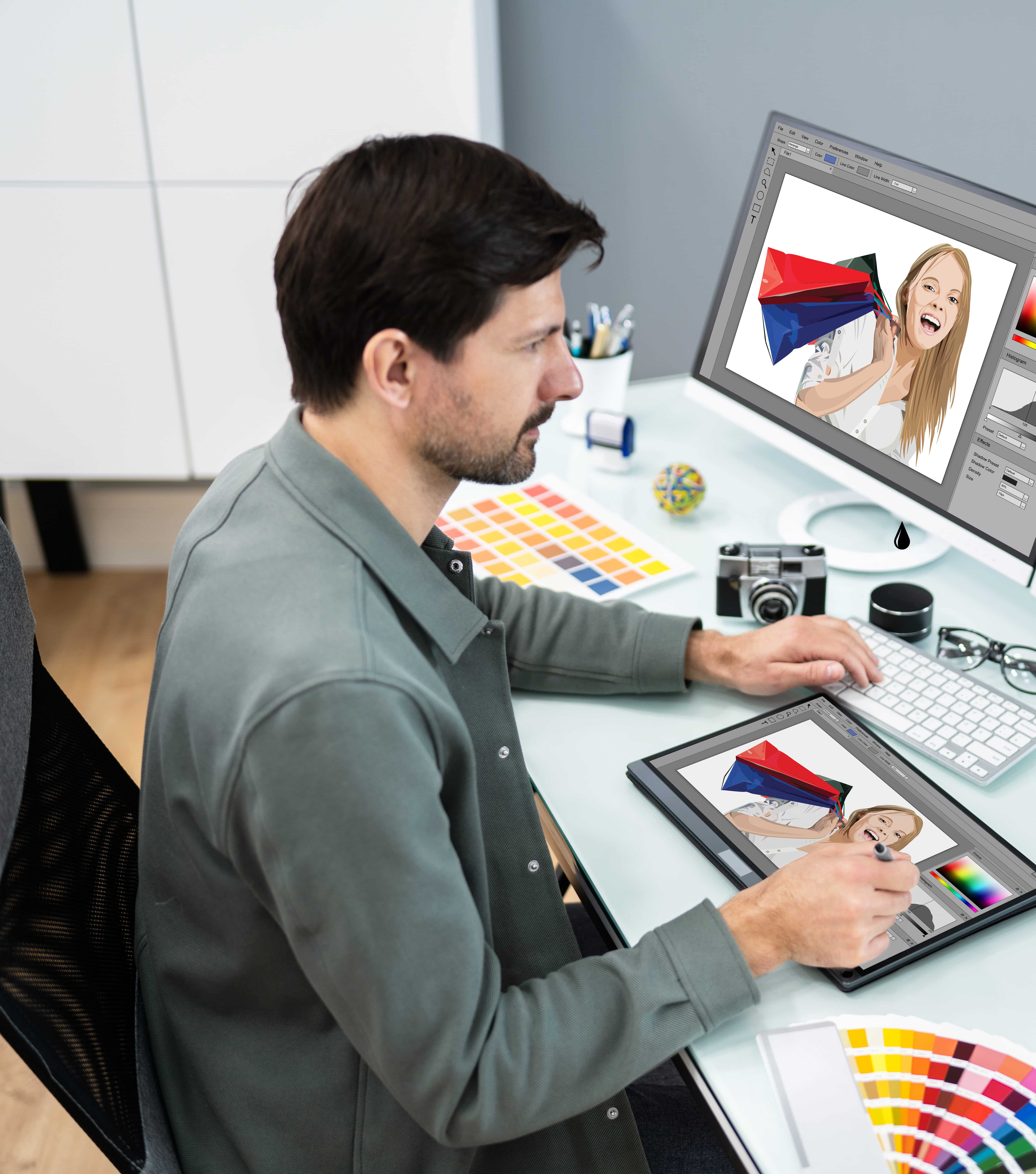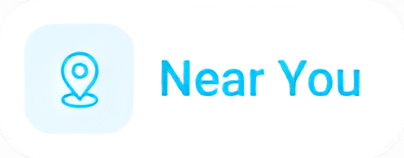







Simply enter the service you need, and your details then press "Spetz-it".
You'll be connected immediately to a nearby top-rated service provider.
Your rating is important. So you can help other customers get the best specialist too.
Hiring the best graphic designer near you in the United Kingdom involves a systematic approach to ensure you find a professional whose skills and style align with your needs. Here’s a step-by-step guide to help you hire the right graphic designer:
1. Define Your Needs:
– Clearly outline the scope of your project. Determine the type of graphic design services you require, such as logo design, branding, web design, print materials, etc.
2. Research and Gather Portfolios:
– Look for local graphic designers through online platforms, design directories, or recommendations. Review their portfolios to assess the quality and style of their work.
3. Check Credentials:
– Verify the graphic designer’s credentials, including education, certifications, and professional affiliations.
4. Read Reviews and Testimonials:
– Check online reviews and testimonials from previous clients. This provides insights into the designer’s reliability and the satisfaction of their clients.
5. Interview Multiple Designers:
– Schedule interviews or consultations with multiple graphic designers. Discuss your project, ask about their design process, and assess their understanding of your brand.
6. Ask About Experience:
– Inquire about their experience in your industry or with similar projects. Experience in your specific niche can be valuable.
7. Review Technical Skills:
– Assess their technical skills with design software, understanding of colour theory, typography, and other design principles.
8. Discuss Style and Aesthetic:
– Ensure the designer’s style aligns with your brand. Discuss your preferences and expectations regarding the visual aesthetics of your project.
9. Clarify Communication Channels:
– Establish clear communication channels. A responsive designer who understands your vision is crucial for a successful collaboration.
10. Discuss Project Timelines:
– Inquire about their availability and the expected timeline for completing your project. Ensure it aligns with your deadlines.
11. Ask About Revision Policies:
– Understand their policy regarding revisions. Discuss how many revisions are included in the project and the process for feedback.
12. Clarify Pricing and Payment Terms:
– Request a detailed quote that outlines the cost breakdown. Understand their pricing structure and payment terms.
13. Discuss Ownership and Rights:
– Clarify the ownership of the final designs and the rights you’ll have to use them for various purposes.
14. Portfolio of Diverse Work:
– Look for a designer with a diverse portfolio, showcasing versatility in design styles and the ability to adapt to different projects.
15. Check for Responsive Design:
– If your project involves web design, ensure the designer understands and can implement responsive design principles for various devices.
16. Consider Collaborative Tools:
– Inquire about the tools and platforms they use for collaboration, especially if you’re working remotely.
17. Discuss Post-Launch Support:
– Ask about post-launch support or maintenance services, especially for web design projects.
18. Legal Agreements:
– Ensure that all terms, including project scope, timelines, and payment details, are documented in a formal contract.
19. Visit Their Website and Social Media:
– Explore their website and social media profiles to get a sense of their professionalism, client interactions, and recent work.
20. Trust Your Instincts:
– Trust your instincts when making a decision. Choose a graphic designer with whom you feel comfortable and confident.
By following these steps, you can identify a skilled graphic designer who can bring your vision to life. Taking the time to research, interview, and assess potential candidates will contribute to a successful and visually appealing design project.
A graphic designer is a professional who specializes in creating visual content to communicate messages, ideas, and information. In the United Kingdom, graphic designers play a crucial role in various industries, utilizing their artistic and technical skills to design visually appealing and effective communication materials. Here’s an overview of what a graphic designer can do in the United Kingdom:
Roles and Responsibilities of a Graphic Designer:
1. Visual Identity and Branding:
– Create or refresh brand identities through the design of logos, colour schemes, and visual elements.
– Develop brand guidelines to ensure consistency across all communication materials.
2. Print Design:
– Design marketing collateral such as brochures, posters, flyers, business cards, and print advertisements.
– Work on packaging design for products.
3. Digital Design:
– Design websites, including the layout, graphics, and user interface elements.
– Create digital advertisements, social media graphics, and email campaigns.
4. Logo Design:
– Develop unique and memorable logos that represent a brand’s identity and values.
5. Typography and Layout:
– Choose appropriate fonts and layout elements to create visually appealing and readable designs.
6. Illustration:
– Create custom illustrations, icons, and graphics to enhance design elements.
7. User Interface (UI) and User Experience (UX) Design:
– Design the visual elements and overall user experience for websites and applications.
– Ensure a seamless and user-friendly interaction with digital products.
8. Infographics:
– Visualize complex information through the creation of infographics that are easy to understand.
9. Social Media Graphics:
– Design graphics for social media platforms to enhance brand visibility and engagement.
10. Motion Graphics:
– Create animated graphics and videos for presentations, websites, and social media.
11. Corporate Communication:
– Design internal and external communication materials for corporate use, including reports, presentations, and newsletters.
12. Environmental Graphics:
– Design graphics for physical spaces, such as signage, wayfinding, and environmental branding.
13. Collaboration with Clients and Teams:
– Work closely with clients to understand their needs and vision.
– Collaborate with marketing teams, copywriters, and other professionals involved in a project.
14. Software Proficiency:
– Utilize graphic design software such as Adobe Creative Suite (Photoshop, Illustrator, InDesign) and other relevant tools.
15. Stay Updated on Design Trends:
– Keep abreast of current design trends, technologies, and industry best practices.
Industries and Sectors:
Graphic designers in the United Kingdom can be found working in various sectors, including:
– Advertising and Marketing Agencies
– Corporate Businesses
– Publishing and Media
– Web Development and Digital Agencies
– Retail and E-commerce
– Non-profit Organizations
– Government and Public Sector
Importance of Graphic Design:
Effective graphic design is essential for businesses and organizations in the UK to:
– Build Brand Identity: Create a consistent and recognizable brand image.
– Communicate Messages: Convey information and messages visually.
– Attract Attention: Grab the audience’s attention with visually appealing designs.
– Enhance User Experience: Improve the usability and aesthetics of digital products.
– Differentiate from Competitors: Stand out in a competitive market through unique designs.
Overall, graphic designers play a key role in shaping the visual communication strategies of businesses and organizations in the United Kingdom. Their work contributes to creating a strong brand presence and facilitating effective communication with target audiences.
Graphic designers in the United Kingdom are skilled professionals who can assist with a wide range of design-related tasks and projects across various industries. Here are some common jobs and projects that graphic designers can help with in the UK:
1. Logo Design:
– Create unique and memorable logos that represent a brand’s identity.
2. Branding and Visual Identity:
– Develop and refresh brand identities, including colour schemes, typography, and visual elements.
3. Print Design:
– Design marketing collateral such as brochures, posters, flyers, business cards, and print advertisements.
4. Digital Design:
– Design websites, including layout, graphics, and user interface elements.
– Create digital advertisements, social media graphics, and email campaigns.
5. Packaging Design:
– Design packaging for products, ensuring it aligns with the brand and attracts consumers.
6. Typography and Layout:
– Choose appropriate fonts and create layouts for various materials, ensuring readability and visual appeal.
7. Illustration:
– Provide custom illustrations, icons, and graphics to enhance design elements.
8. User Interface (UI) and User Experience (UX) Design:
– Design the visual elements and overall user experience for websites and applications.
9. Infographics:
– Visualize complex information through the creation of infographics that are easy to understand.
10. Social Media Graphics:
– Design graphics for social media platforms to enhance brand visibility and engagement.
11. Motion Graphics:
– Create animated graphics and videos for presentations, websites, and social media.
12. Corporate Communication:
– Design internal and external communication materials for corporate use, including reports, presentations, and newsletters.
13. Environmental Graphics:
– Design graphics for physical spaces, such as signage, wayfinding, and environmental branding.
14. Publication Design:
– Design layouts for books, magazines, and other publications, ensuring a cohesive and visually pleasing presentation.
15. Event Graphics:
– Create graphics for events, including banners, posters, and promotional materials.
16. Illustrative Storytelling:
– Develop visual narratives for storytelling purposes, such as in presentations or promotional materials.
17. Social and Political Campaigns:
– Design materials for social or political campaigns, including posters, flyers, and digital content.
18. Educational Materials:
– Design educational materials, presentations, and visuals for teaching purposes.
19. Custom Merchandise:
– Design graphics for custom merchandise, such as T-shirts, mugs, and promotional items.
20. Photomanipulation and Retouching:
– Enhance and manipulate photographs for various purposes, including advertising and branding.
Graphic designers play a vital role in enhancing visual communication and creating a strong visual presence for businesses and organizations. Their skills extend across both traditional and digital mediums, making them valuable collaborators in a wide range of creative projects in the United Kingdom.
The cost of hiring a graphic designer in the United Kingdom can vary widely based on factors such as the designer’s experience, the complexity of the project, the scope of work, and the geographic location. Graphic designers may charge for their services in different ways, including hourly rates, project-based fees, or a combination of both. Here are some general guidelines regarding the cost of hiring a graphic designer in the UK:
1. Hourly Rates:
– Entry-Level Designers: £15 to £30 per hour
– Mid-Level Designers: £30 to £50 per hour
– Experienced Designers: £50 to £100+ per hour
2. Project-Based Fees:
– Logo Design: £200 to £2,000+
– Brochures and Print Collateral: £300 to £3,000+
– Website Design: £500 to £10,000+
– Social Media Graphics: £50 to £500 per platform
– Branding Packages: £1,000 to £5,000+
3. Factors Influencing Costs:
– Experience: More experienced designers typically charge higher rates.
– Scope of Work: The complexity and scale of the project will impact the cost.
– Industry: Designers with expertise in specific industries may charge premium rates.
– Urgency: If a quick turnaround is required, it may incur additional costs.
– Geographic Location: Designers in major cities may charge higher rates due to the cost of living.
4. Additional Costs:
– Stock Images and Fonts: If the project requires the purchase of stock images or fonts, these costs may be passed on to the client.
– Printing Costs: For print projects, the cost of printing materials is an additional consideration.
5. Payment Structure:
– Designers may request an upfront deposit before starting the project, with the balance due upon completion or at specific project milestones.
6. Value-Added Services:
– Some designers may offer additional services such as branding consultations, marketing strategy, or ongoing support, which can affect overall costs.
It’s important to communicate clearly with the graphic designer about your budget, expectations, and the scope of the project. Obtain a detailed quote or estimate that outlines the services included, any additional costs, and the payment schedule. Additionally, review the designer’s portfolio and discuss your project requirements during an initial consultation to ensure a good fit.
Ultimately, the cost of hiring a graphic designer should reflect the value they bring to your project, and it’s worth investing in a designer whose skills align with your branding and communication goals.
When hiring a local graphic designer in the United Kingdom, asking the right questions is crucial to ensure that the designer is the right fit for your project. Here are some important questions to ask:
1. Experience and Background:
1. How many years of experience do you have as a graphic designer?
2. Can you provide examples of projects similar to mine that you’ve worked on?
2. Portfolio and Style:
3. Can you show me your portfolio?
4. How would you describe your design style?
5. Do you have experience working with businesses in my industry?
3. Design Process:
6. Can you walk me through your design process from concept to completion?
7. How do you gather information about a client’s brand and vision before starting a project?
4. Software and Tools:
8. What design software do you primarily use?
9. Are you familiar with industry-standard design tools such as Adobe Creative Suite?
5. Communication and Collaboration:
10. How do you prefer to communicate with clients?
11. What level of client involvement do you encourage during the design process?
12. How do you handle feedback and revisions?
6. Project Management:
13. What is your typical turnaround time for projects of this scope?
14. Do you have the capacity to take on my project within my desired timeline?
7. Costs and Billing:
15. What is your pricing structure? Hourly, project-based, or a combination?
16. Can you provide a detailed estimate for my specific project?
17. Are there any additional costs I should be aware of, such as stock images or printing fees?
8. Ownership and Usage Rights:
18. Who will own the final design, and what usage rights will I have?
19. Do you provide the source files once the project is complete?
9. References and Testimonials:
20. Can you provide references from past clients?
21. Do you have any client testimonials or reviews I can read?
10. Legal and Contractual Matters:
22. Do you use contracts for your projects?
23. What is your policy regarding revisions and changes after the project has started?
11. Availability and Workload:
24. Are you currently working on other projects, and do you have the capacity for mine?
12. Post-Launch Support:
25. Do you offer any post-launch support or assistance?
13. Stay Updated on Trends:
26. How do you stay updated on design trends and industry changes?
14. Collaboration with Other Professionals:
27. Do you collaborate with other professionals, such as copywriters or photographers, if needed?
15. Environmental Considerations:
28. Are you mindful of sustainable and environmentally friendly design practices?
16. Educational Background and Certifications:
29. What is your educational background in graphic design, and do you have any relevant certifications?
17. Scalability:
30. Can you accommodate the potential growth or scaling of my business in the design elements you create?
Asking these questions will help you gain a comprehensive understanding of the graphic designer’s capabilities, work process, and whether they align with your project requirements. It also allows you to assess their communication style and professionalism, which are crucial for a successful collaboration.